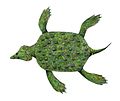| Leptocleididae Temporal range: Early Cretaceous, | |
|---|---|
 | |
| Leptocleidus | |
| Scientific classification | |
| Kingdom: | Animalia |
| Phylum: | Chordata |
| Class: | Reptilia |
| Superorder: | † Sauropterygia |
| Order: | † Plesiosauria |
| Superfamily: | † Plesiosauroidea |
| Clade: | † Leptocleidia |
| Family: | † Leptocleididae White, 1940 |
| Genera | |
Leptocleididae is a family of small-sized plesiosaurs that lived during the Early Cretaceous period (early Berriasian to early Albian stage). [1] They had small bodies with small heads and short necks. Leptocleidus and Umoonasaurus had round bodies and triangle-shaped heads. Leptocleidids have been found in what were shallow nearshore, freshwater and brackish habitats. [2] Hilary F. Ketchum and Roger B. J. Benson (2010), transferred Brancasaurus , Kaiwhekea , Nichollssaura and Thililua to this family. [3] However, Ketchum and Benson (2011) reassigned Kaiwhekea and Thililua to their original positions, as an elasmosaurid and a polycotylid, respectively. [1]






